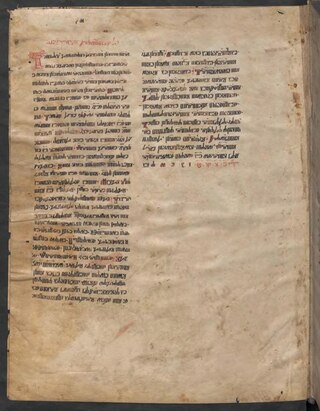
Roč is a village in Istria County, north-west Croatia. Administratively it belongs to the town of Buzet. Roč is considered a historic town rather than a village due to its rich cultural heritage.

Church Slavonic, also known as Church Slavic, New Church Slavonic, New Church Slavic or just Slavonic, is the conservative Slavic liturgical language used by the Eastern Orthodox Church in Belarus, Bosnia and Herzegovina, Bulgaria, North Macedonia, Montenegro, Poland, Ukraine, Russia, Serbia, the Czech Republic and Slovakia, Slovenia and Croatia. The language appears also in the services of the Russian Orthodox Church Outside of Russia, the American Carpatho-Russian Orthodox Diocese, and occasionally in the services of the Orthodox Church in America.

Perušić is municipality (općina) in Lika-Senj County, Croatia. The municipality has 2,638 inhabitants, while the settlement itself has 852. The municipality is within the mountainous Lika region of central Croatia. The Kosinj valley region sprawls alongside it.

The Kiev Missal is a seven-folio Glagolitic Old Church Slavonic canon manuscript containing parts of the Roman-rite liturgy. It is usually held to be the oldest and the most archaic Old Church Slavonic manuscript, and is dated at no later than the latter half of the 10th century. Seven parchment folios have been preserved in small format of easily portable book to be of use to missionaries on the move.

The Hrvoje's Missal is a 15th-century missal written in Glagolitic alphabet.
Eduard Hercigonja was a Croatian philologist, Croatist and literary historian. University professor and a member of the Croatian Academy of Sciences and Arts, he authored several fundamental works on medieval Croatian literature and culture.
Order of Mass is an outline of a Mass celebration, describing how and in what order liturgical texts and rituals are employed to constitute a Mass.

Kosinj, also known as Kosinj Valley, is a hilly region in Perušić municipality, Lika-Senj County, Croatia. It contains three villages: Gornji Kosinj and Donji Kosinj, which are connected by the Kosinj Bridge on the Lika river, and Bakovac Kosinjski. The population of the villages is 752 according to the 2011 census.

Blaž Baromić was a Croatian printer, scribe, founder of the Senj printing press in 1494, the second oldest Croatian printing press. He is also known for his special typographic set known as Baromić technique of refracted ligatures, unique among incunabulas.

Missal of duke Novak was a 14th-century Glagolitic missal. The letters of the missal were later used for the first Croatian printed book Missale Romanum Glagolitice.

Fragmenta Vindobonensia, also known as the Vienna folios, is the name of two illuminated Glagolitic folios that most likely originate from 11th or 12th-century Croatia and Dalmatia.

Spovid općena is the name of the first Croatian language printed book from 1496. It was printed in the printing press of Senj, Croatia and its process was overseen by Blaž Baromić. It was published some thirteen years after the first Croatian printed book Missale Romanum Glagolitice, written in Old Church Slavonic. It contains 36 leaves, and is also the first Croatian non-liturgical incunabula. The book is a translation of "Confessione generale" by the Milanese author Michele Carcano. The translation work was done by Jakov Blažiolović. The opening lines are "Počine spovidь opĉena ča est načinь ki ima držati č[lovi]kь naispita ñe konšencie kad se oĉe ispovid[a]ti".

Glagolitic numerals are a numeral system derived from the Glagolitic script, generally agreed to have been created in the 9th century by Saint Cyril. They are similar to Cyrillic numerals, except that numeric values are assigned according to the native alphabetic order of the Glagolitic alphabet. Use of Glagolitic script and numerals declined through the Middle Ages and by the 17th century Glagolitic was used almost only in religious writings. It is unclear if the use of Glagolitic numerals persisted as long as the use of Glagolitic script.
George of Slavonia was a medieval theological writer and professor at the University of Sorbonne in Paris. He was also a priest in the city of Tours. He is notable for his writings on Glagolitic alphabet and the Croatian lands.

Angular Glagolitic, also known as Croatian Glagolitic, is a style of Glagolitic book hand, developing from the earlier Rounded Glagolitic. Many letters present in Rounded Glagolitic were gradually abandoned: ⱏ, ⱐ, ⱔ, ⱘ, ⱙ, ⱚ, ⱛ and to a large extent ⰿ and ⱗ. Others were introduced, like ⱜ.

Simon Greblo was a Croatian priest, intellectual, Glagolitic writer and scribe. He was one of the most noted connoisseurs of the Glagolitic alphabet at the end of the 15th century. Greblo is generally considered the brightest Croatian copyist of his day. His calligraphy has been especially praised. While not an original author, his knowledge of cultural and literary interests of the day, taste and acumen in making literary choices have been noted.

Žakan Juri, was a Croatian Glagolitic deacon and herald of the first Croatian printed book.

The Interpretation of the Passion of our Lord Jesus Christ is a 15th-century work of narrative prose written in Glagolitic alphabet by the Glacolitic priest Simon Greblo.















